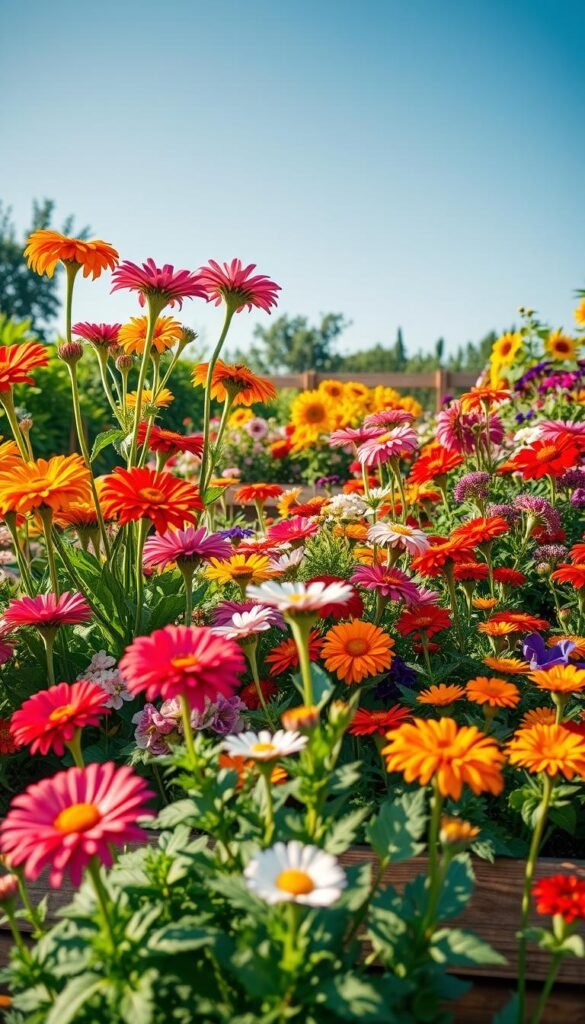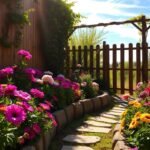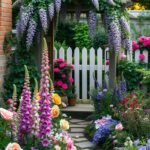Imagine stepping outside to a living canvas of bold hues and lush textures that brighten your yard. Elevating plants in structured beds offers a fresh approach to landscaping, combining practicality with visual appeal. These setups let you craft eye-catching arrangements while simplifying upkeep—perfect for balancing beauty with a busy schedule.
Why choose this method over traditional planting? Improved soil quality and enhanced drainage give roots the ideal environment to thrive. You’ll spend less time battling weeds and more enjoying blossoms like fiery canna lilies or delicate bellflowers. Even compact areas become opportunities for creativity, turning unused corners into focal points.
From sunny zinnias to fragrant roses, the plant options are endless. Mix heights and bloom times for year-round interest, or stick to seasonal favorites that dazzle in summer. This guide walks through designing layouts that suit your space, whether you’re refreshing a patio border or overhauling an entire yard.
Ready to transform your property into a dynamic retreat? We’ll share soil-prep secrets, layout tricks, and maintenance shortcuts used by experts. Discover how structured planting spaces unlock new possibilities for every skill level and plot size.
Getting Started with Your Raised Bed Flower Garden
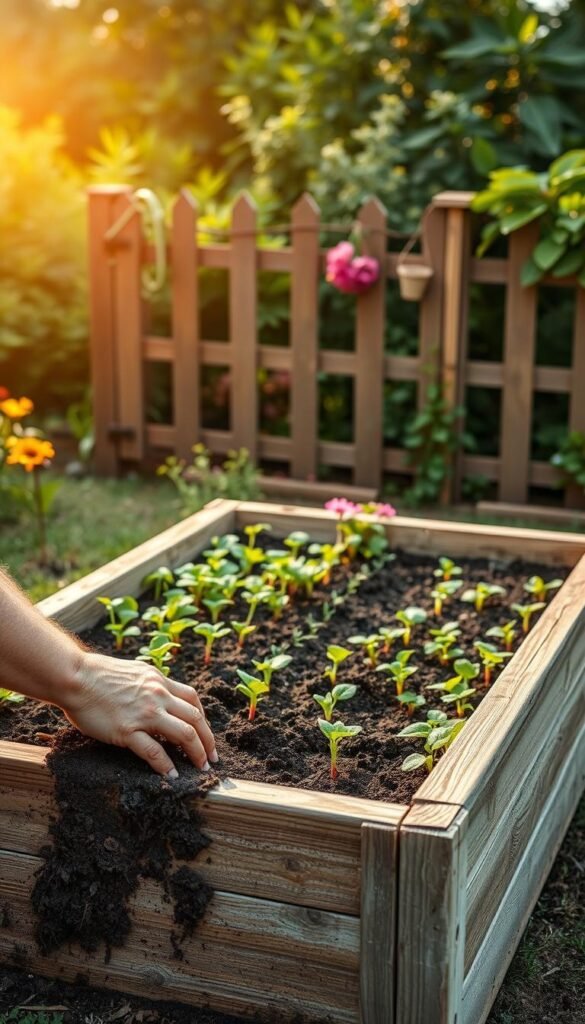
Ready to turn your outdoor space into a blooming retreat? Let’s begin with the basics. The secret to a thriving flower bed lies in your soil. Start by loosening the top 3-4 inches with a garden fork—this breaks up clumps and lets roots breathe. Mix in compost or slow-release fertilizer to feed your plants and stop weeds from stealing nutrients.
Next, play detective with your yard. Does your space get six hours of sun daily, or is it mostly shaded? Match plants to your conditions—sun-loving marigolds won’t thrive under trees, but hostas will. Local nurseries can suggest native species that handle your weather patterns naturally.
Don’t forget drainage! Add perlite or coarse sand if water pools after rain. This simple step prevents root rot and keeps plants healthy. Test your soil’s pH too—most flowers prefer slightly acidic conditions (6.0-7.0).
Now you’re set to get started. With prepped soil and smart plant picks, your flower bed becomes a low-maintenance showstopper. Ready to dig in?
Planning and Preparing Your Garden Space
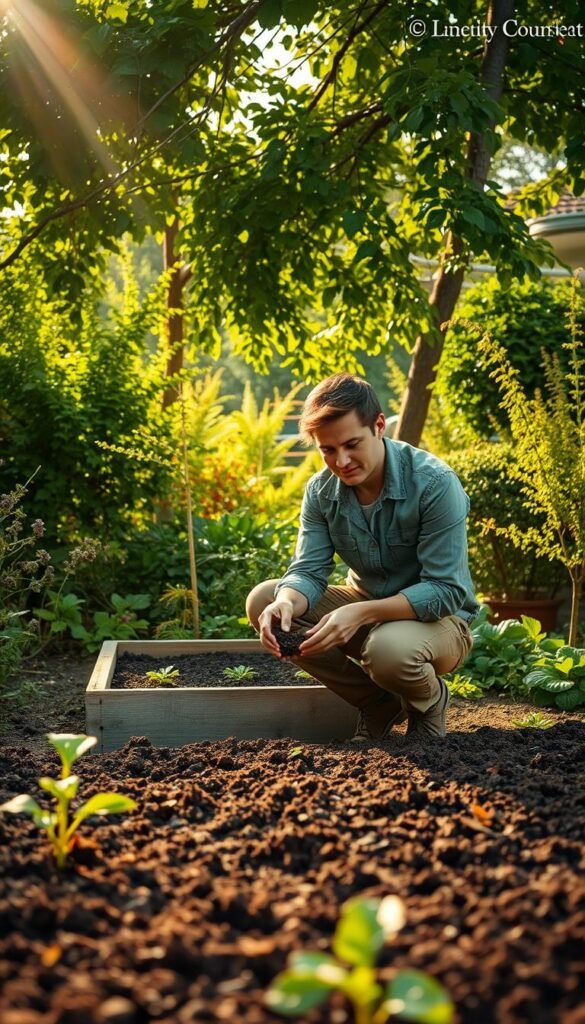
Create a flourishing outdoor retreat by understanding your unique growing conditions. Start by observing how light moves across your space—track sunny spots morning to evening. This reveals where sun-loving blooms or shade-tolerant varieties will thrive best.
Assessing Your Outdoor Space and Sunlight
Grab a notebook and sketch your area’s layout. Mark zones that get:
- 6+ hours of direct sun (ideal for zinnias or coneflowers)
- 3-6 hours (perfect for hydrangeas or impatiens)
- Less than 3 hours (hostas thrive here)
Check your USDA hardiness zone to pick plants suited for local weather patterns. Native species like black-eyed Susans often outperform exotic options with minimal care.
Soil Preparation and Fertilization Techniques
Test your soil’s pH using a $10 kit from garden centers. Most flowering plants prefer 6.0-7.0. If it’s too acidic, mix in crushed limestone. For alkaline soil, add sulfur or peat moss.
Boost nutrient levels with these amendments:
- Compost for organic matter
- Worm castings for slow-release nitrogen
- Perlite for improved drainage
Mix amendments into the top 8 inches of your flower bed. This creates a rich foundation that supports vibrant growth all season.
Expert Tips for a Successful Flower Bed
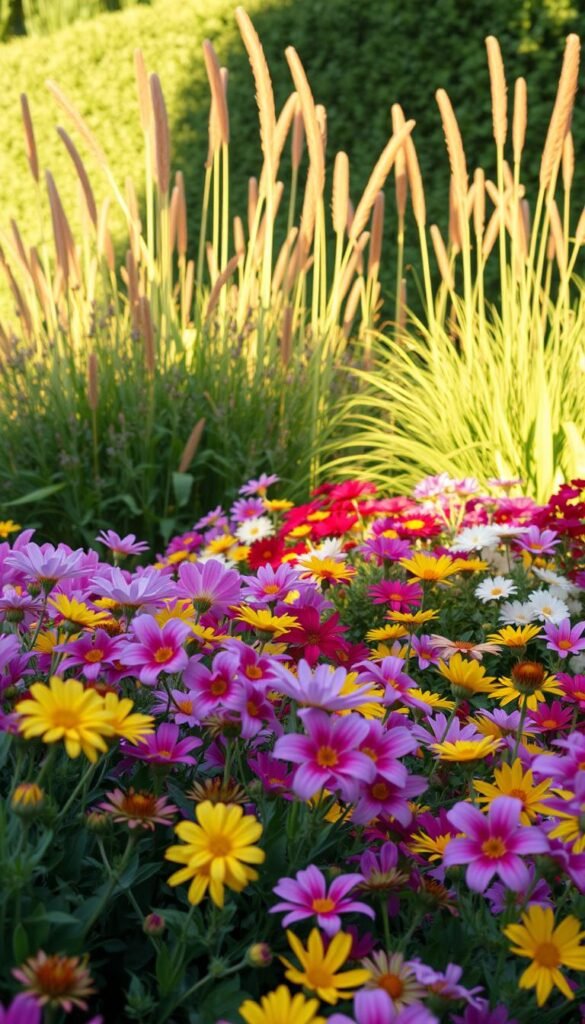
Transform your outdoor space into a living masterpiece with smart design strategies. Professional gardeners use layering and seasonal timing to create dynamic displays that captivate year-round. Let’s explore two game-changing methods to elevate your green space.
Layering: Tall, Mid, and Low Plants for Depth
Create museum-worthy arrangements using height variation. Start with vertical accents like hollyhocks or sunflowers at the back of your flower bed. Fill the middle with bushy salvias or cone flowers, then edge with creeping thyme or sweet alyssum. This approach ensures every plant gets noticed while maximizing space.
| Plant Height | Examples | Bloom Period |
|---|---|---|
| Tall (3-6 ft) | Foxglove, Delphinium | Late Spring-Fall |
| Mid (1-3 ft) | Coreopsis, Lavender | Summer-Fall |
| Low (under 1 ft) | Sedum, Dianthus | Spring-Fall |
Seasonal Bloom Planning for Year-Round Interest
Keep your flower bed lively through all seasons with strategic plant selection. Pair early bloomers like crocuses with late performers such as asters. Mix perennials like daylilies with annuals like petunias for constant color shifts. Evergreen shrubs provide winter structure when other plants rest.
| Season | Perennial Picks | Annual Fillers |
|---|---|---|
| Spring | Bleeding Heart | Pansies |
| Summer | Shasta Daisy | Zinnias |
| Fall/Winter | Ornamental Kale | Snapdragons |
Rotate plants seasonally to maintain freshness. Track bloom cycles in a gardening journal – you’ll spot patterns to refine your design over time. With thoughtful planning, your flower bed becomes an ever-changing work of art.
Creating Layers and Visual Interest in Your Garden
Turn your outdoor area into a dynamic display by playing with depth and contrast. Start with ornamental grasses like miscanthus or blue oat grass—their wispy stalks add movement while framing bold blooms. Place taller varieties behind shorter plants to guide the eye through your flower bed naturally.
Combine feathery grasses with broad-leafed shrubs for instant texture. Try pairing fountain grass with hydrangeas, or use spiky yucca alongside soft lamb’s ear. This mix creates tactile contrasts that make your space feel curated yet wild.
| Plant Height | Examples | Texture Type |
|---|---|---|
| Tall (4-6 ft) | Pampas Grass, Joe-Pye Weed | Feathery/Bold |
| Mid (2-3 ft) | Russian Sage, Black-Eyed Susan | Fine/Coarse |
| Low (6-12 in) | Creeping Phlox, Sedum | Soft/Spiky |
Create “peek-a-boo” moments by positioning slender plants at angles. Blue oat grass’s arching blades can partially obscure dahlias, inviting viewers to explore further. This technique works especially well in curved gardens where paths reveal new details as you walk.
Balance your design by anchoring bold elements with subtle textures. A single smoke bush makes purple coneflowers pop, while drift roses soften ornamental grasses’ sharp lines. For more ways to elevate your space’s visual appeal, explore our guide to strategic plant pairing.
Remember: odd numbers create harmony. Group three matching grasses or five similar perennials for a polished look. Your flower bed will transform into a living sculpture that changes with every breeze.
Designing with Color and Texture
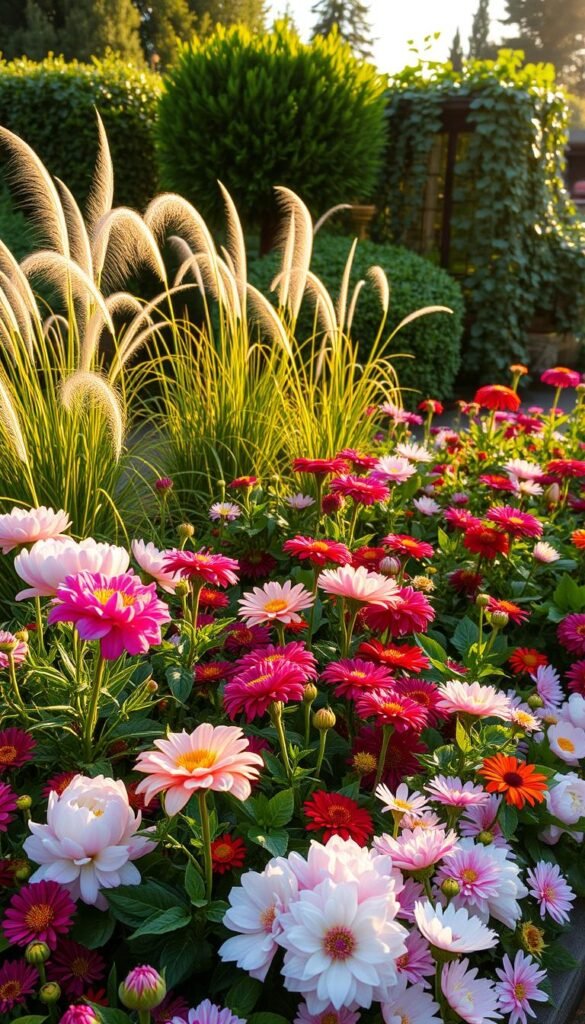
What if your outdoor space could dazzle like a painter’s palette? Strategic use of hues and materials turns ordinary plantings into living art. Start by choosing three main colors—a bold base, a complementary secondary shade, and an accent tone that pops against greenery.
Selecting Vibrant Flower Choices
Pair purple salvia with yellow marigolds for electric contrast, or blend pink petunias into coral geraniums for a sunset effect. Pro tip: Group same-color blooms in odd numbers (3, 5, 7) for natural rhythm. Try this combo:
- Ruby-red celosia (front row)
- Orange marigolds (middle)
- Golden coreopsis (back)
Using Foliage and Edging to Enhance Texture
Silver dusty miller leaves make purple pansies glow, while spiky yucca adds drama to soft begonias. Frame your masterpiece with:
| Material | Style | Maintenance |
|---|---|---|
| Recycled bricks | Rustic | Low |
| Smooth river rocks | Modern | Medium |
| Weathered wood | Cottage | High |
Balance bold elements with subtle touches—a row of white alyssum softens stone borders, while variegated hosta leaves tie together mixed colors. Your space becomes a visual symphony that changes with each season.
Low Maintenance Flower Bed Ideas for Your Front Yard
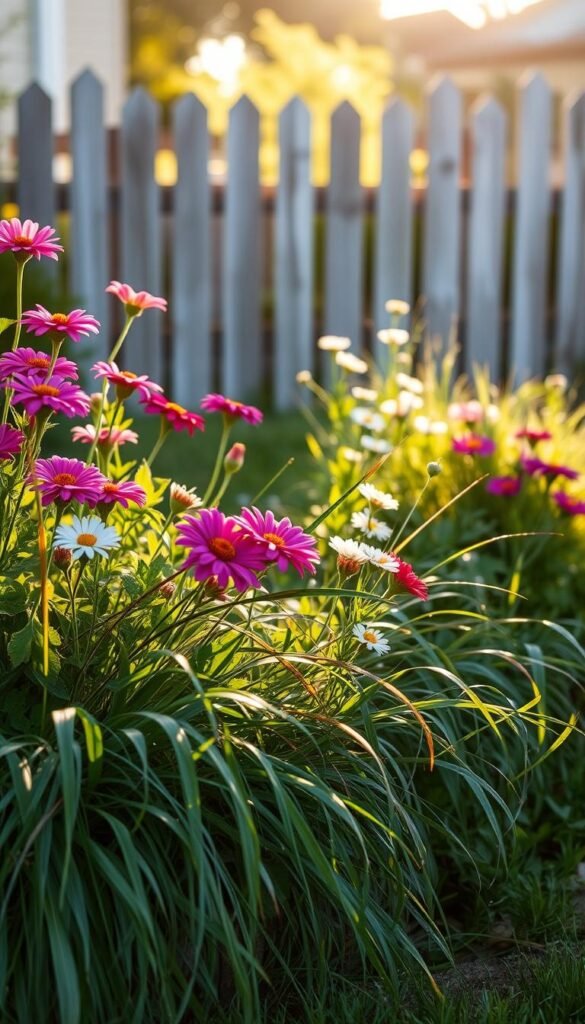
Your front yard deserves a vibrant makeover that doesn’t demand weekend-long chores. Native plants are the ultimate hack for busy homeowners—they’re already adapted to your area’s rainfall, soil, and temperature swings. This means less watering, fewer pests, and more time enjoying your curb appeal.
Start by choosing drought-tolerant perennials like coneflowers or blanket flowers. These hardy bloomers return yearly with minimal effort. Pair them with ornamental grasses for movement and structure. Need design inspiration? Explore these flower bed ideas that balance beauty and practicality.
| Region | Plant Examples | Bloom Time | Care Level |
|---|---|---|---|
| Northeast | Black-Eyed Susan, Bee Balm | Summer-Fall | Low |
| Southwest | Desert Marigold, Penstemon | Spring-Fall | Very Low |
| Midwest | Coneflower, Prairie Dropseed | Summer | Moderate |
Group plants with similar needs to streamline care. A sunny corner could host lavender and sedum, while shaded areas might feature coral bells and ferns. Mulch generously to suppress weeds and retain moisture—this one step cuts maintenance by 30%.
For guaranteed success, try these low-maintenance flowers that thrive across most zones. Their strong root systems handle dry spells, and natural pest resistance means no chemical sprays. Your front yard becomes a self-sufficient showcase that impresses neighbors without weekend marathons.
Innovative Raised Bed and Vertical Garden Installations
Who says you need sprawling grounds to cultivate stunning botanical displays? Compact yards and patios become lush retreats when you grow upward. Vertical gardening techniques let you triple planting areas without expanding your footprint—perfect for urban spaces or cozy corners.
Space-Saving Vertical Solutions
Transform blank walls into living tapestries with these clever approaches:
- Modular wall planters for herbs or trailing petunias
- Tiered trellis systems supporting climbing roses or clematis
- Hanging pocket gardens filled with colorful annuals
Pair structural elements with functional beauty. An arbor draped in morning glories becomes both shade provider and floral showcase. For step-by-step guidance, explore these vertical garden techniques that maximize every inch.
| Structure | Best Plants | Space Saved |
|---|---|---|
| Wall Planter | Succulents, Strawberries | 85% |
| Freestanding Tower | Salad Greens, Pansies | 75% |
| Rail Planter | Herbs, Miniature Roses | 90% |
Built-in beds along fences or staircases create seamless transitions between hardscape and greenery. Use matching containers to unify disparate areas—cluster three identical pots along a walkway for rhythm. Your patio becomes an immersive experience where every level tells a story.
Raised Bed Flower Garden Ideas: Adding Color and Texture to Your Landscape
Ever wondered how to make every inch of your outdoor space work harder? Let’s explore clever ways to position plantings that deliver beauty and function. Fence lines become instant showstoppers when layered with feathery miscanthus behind clusters of dwarf marigolds. This combo offers privacy while creating a living curtain of color.
Transform forgotten corners into design features. That bare patch under your maple tree? Circle it with shade-loving astilbes and coral bells. Their vibrant foliage brightens the area without competing with tree roots. For sloped spaces, build terraced planters using our step-by-step raised bed guide to prevent erosion while showcasing petunias.
Consider sightlines from your home’s windows and seating areas. Place bold bloomers like dahlias where they’ll catch afternoon light, ensuring maximum visibility. One homeowner transformed their side yard by installing staggered planters along a winding path—now it’s their favorite sunset-viewing spot.
| Location | Plant Pairing | Key Benefit |
|---|---|---|
| Fence Line | Fountain Grass + Zinnias | Privacy + Pollinators |
| Tree Base | Hostas + Impatiens | Color in Shade |
| Sloped Area | Sedum + Creeping Phlox | Erosion Control |
Even narrow strips beside driveways shine when planted with vertical accents. Try tall verbena flanked by silver mound artemisia—their contrasting textures make the space feel intentional. Remember: successful layouts work with your land’s natural features rather than against them.
Attracting Pollinators with Thoughtful Plant Selections
Turn your garden into a buzzing sanctuary by welcoming nature’s hardest workers. Selecting the right blooms transforms your space into a pit stop for bees, butterflies, and hummingbirds while boosting local ecosystems.
Blooms That Bring Winged Visitors
Start with native species that match your region’s climate. Cornflowers and milkweed attract monarchs, while salvia’s tubular flowers draw hummingbirds like magnets. Cluster similar plants together—bees prefer visiting multiple blooms in one trip.
| Plant | Attracts | Bloom Period |
|---|---|---|
| Purple Coneflower | Bees, Butterflies | Summer-Fall |
| Bee Balm | Hummingbirds | Mid-Summer |
| Goldenrod | 40+ Pollinator Species | Late Summer |
Building a Wildlife Oasis
Mix early and late bloomers to provide nectar year-round. Add shallow water sources and leave some bare ground for nesting. Avoid pesticides—even organic ones can disrupt delicate ecosystems.
- Plant in groups of 3-5 for visibility
- Include night-blooming flowers for moths
- Let herbs like oregano flower for extra food sources
Your garden becomes more than pretty—it’s a lifeline for local wildlife. Watch as pollinators turn your flowers into a vibrant hub of activity!
Establishing Creative Edging and Borders
Define your outdoor masterpiece with borders that do more than just contain plants. Clever edging creates crisp lines between your lush plantings and pathways, while stopping grass invasions. These transitional zones become design features when crafted with care.
DIY Techniques Using Rocks, Brick, or Wood
For a natural vibe, line beds with local stones. Stack flat rocks vertically for height, or lay larger ones horizontally. This approach blends seamlessly with existing landscapes and requires no special tools.
Salvaged bricks add timeless charm. Bury them halfway in staggered patterns for visual rhythm. They’ll withstand weather while complementing both modern and cottage-style spaces.
Reclaimed timber brings rustic warmth. Secure pressure-treated boards at 45-degree angles to prevent soil spillage. Rot-resistant cedar lasts longest in damp conditions.
Each material solves practical needs while expressing personal style. Your borders become the frame that highlights nature’s artwork.

